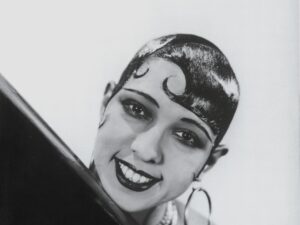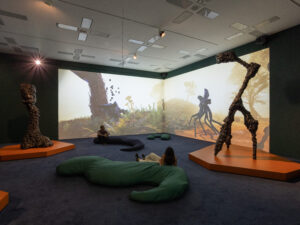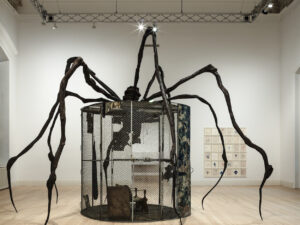An interview with the french interior Designer Franck Genser
Interior Designer Franck Genser – “It all starts with the table!”
Franck Genser is a for his distinctive designs well-recognized French interior designer, based in Paris. In 1992, he graduated from the Ecole Nationale Supérieure de Géologie in France. Inspired by Jacques Emile Ruhlmann and art déco, Franck Genser focusses on the concept of Gestalt therapy, on the process of the contact between the organism and its environment through emotions, light, surfaces, materials, shapes, sounds, raw materials, architecture, and through the encounter with the individual. The designer is also known for his free and often unexpected view in designing. His creations provide a strong utility aspect. With the recent launch of the movement “Design du Champ”, he presents a new style and a new design perspective of a writing desk, the bureau Chumtak, which will be soon on display in an exhibition. Plus: His new private showroom, located on Boulevard Saint-Germain, Paris, will open within the next weeks.
Fräulein: Explain us why you designed this new type of desk, the bureau “Chumtak”?
Franck Genser: In fact, the idea was to work on power. And power is exercised in the ambiance. It’s something unseizable. Some people have natural authority, for example, but there are others who, whatever they say, fail to act on the environment. And so, the idea was to see if I could design a bureau but which ultimately sets up a link. It means that if I am behind a Louis XV desk, I have configured a certain type of link. Maybe today in France when foreign people see our president of the republic with a Louis XV desk, they do not necessarily understand what is going on with this Louis XV desk, they may expect to see them hurtling in a livery with powdered wigs that will come out from behind the door and then these big moccasins with silver buckles that would ultimately translate from the old regime, something monarchical. I tried to do something that is much more timeless, more spiritual and that is also presented in a more simple form within a meeting setting, which allows not only that, but which is still extremely powerful. The image I had for the bureau is an image of power at the same time with a soft touch that allows meetings without the effects of domination of distancing.
FR: Do we need less distance today and if so, why?
FG: I think, it depends on the paradigm we have. If we are in a monarchical paradigm, we are suffering from divine right, which means that we are in the spirit and power of God. Power is loaned to us. It is occupied for a while, but it is not a state. There is more language used in France where people say: I am the president. Maybe they should say: I am taking care of the role of a president.That’s a bit different. And I think, I did the bureau definitively for a president. I did it for France, I designed it as something that could embody or give substance to the spirit of what I imagined to be a modern leader. It is quite difficult, since – at the same time – we can ask the question of why. Why is there no new desk? We are still with this Louis XV desk. There have been attempts by Georges Pompidou and François Mitterrand when they tried to implement a writing desk at the Palais d’Elysée which had been created by Pierre Paulin – but ultimately, it did not continue. This desk could not prevail because it did not embody the function. Today what embodies the function is still the Louis XV desk. But I did not launch it for a person, I tried to embody a more modern way, for the role of a leader. Even I was talking about the president of the republic, it could also be a woman. It is a table that could be as feminine as masculine. Designing it, it’s a big job anyway.
FR: Do you need a certain ambiance for this table or how does it fit into a setting?
FG: No, I don’t think so. I think what’s interesting is the fact that it fits everywhere. The bureau is very sober. And that was also something I tried to realize. It wasn’t defined to fit only in a certain place. But it measures 2.45 meters. You still need a room of a certain size, of course, like the presidential office of a large company, for example.
FR: What are the specifics of the Chumtak?
FG: We have a great table: we have a worktable, for sitting or standing, it is a mechanically suspended table, it is very light and very well adjusted. It features an oval parchment where eight people can be positioned around for a meeting.
FR: You work by the concept of Gestalt therapy. How does this concept apply on this table and within a space?
FG: Mainly, it is a work about contact. What is happening? What is going on with this contact? What is the process of contact? And then I work on the field. The field is what we perceive and, effectively, these are the things that come from Gestalt therapy and which I put into practice by configuring the field. Our experience of encounters will be strongly colored for example by an ambiance, by the light, also by the materials. In my case, when I arrive at a place or in a room, I start by perhaps delimiting the space. This limiting process can be done in different ways, with a carpet or directly by the choice of a floor, with lighting. Finally, it should already be organized, which zone will represent which function. And then, once you have done that, you put in a table! A table that will be adapted to the function and which will render in the field. Is it a workspace? What is the story?
FR: How do you describe the style or the trend for the next 5 to 10 years from now? How can we imagine what people are going to like?
FG: First of all, I am very happy that you ask this question. Today, we have lived in the last 30 years on what I call “the heritage of the grandmother”. In the 1980ies, people had furniture from the 1930ies which was very fashionable and started already to be a trend with art deco. And then today – for about five years – we have moved on to the furniture from the 1950ies because these people who were born in the 30ies, they possessed this furniture. The grandparents passed away and they left it scattered and it ended up being recycled. And it became a new fashion. It still translates an era that is ours, which is an era still turned towards the past more than towards the future. Fortunately, people from the 1930ies and 1950ies did not recover the furniture from 1880 because otherwise we would not have things from the 50ies to recover. So here they are, in 1950, in 1930 or 1925, they succeeded in creating styles to imprint an approach. Today, I am pleading for a return to materials. That is to say that we really get in touch with the material. Everything that happens in contact with wood, everything that happens in contact with leather, wool, noble materials, and the fact that when materials go through time, they will provide patina, they get more and more beautiful. There are not many things that are well fabricated today. I can just say what I think. For me, what will remain of our time, that is ultimately a question we can ask ourselves. What will there be in our time? But we could already ask the question of what our era will leave for the future. Which form, for example? Is there a style that stands out, a furniture design, a special material?
FR: Do you think it is harder to be a designer today?
FG: I don’t think it’s harder or easier. It’s perhaps the most difficult job in the world. You have designers who manage to create brands which means that the designer himself is a brand and people no longer question the work. And I’m not going to mention any names because I don’t want to be rude. I think that we should ask ourselves the questions for certain designers who are very famous: What are they going to leave to history, what will history return to them, who had become known for being famous? I don’t know. Maybe I am wrong, and I would be very happy if so. It’s not against them. What I am simply saying is that this functioning of the brand is the fact that we subconsciously assign a value to a name. It seems actually enough, not to ask a question. Me, I expect the client to ask a few questions at least. It is a sensitive response that we try to bring to the client.
The interview was held in May 2020 in the Parisian atelier of Franck Genser, located in the 13th arrondissement, where the designer and his team are creating all the prototypes and new projects. For more information and appointments, please visit: www.franckgenser.com
Text: Elisa Gianna Gerlach


